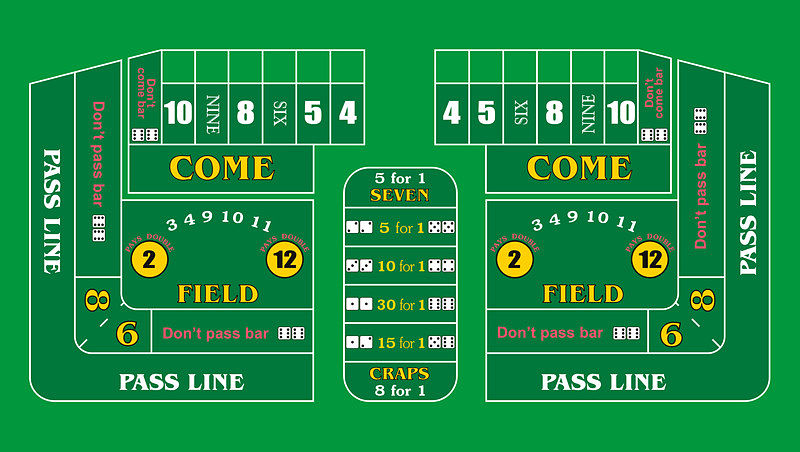
A typical craps table layout
You’ll definitely want to learn how to play craps if you’re planning on a visit to the casino. It’s one of the most popular casino table games and with good reason. You’ll often see crowds of people round the craps table whooping and hollering as they take it in turns to roll the dice. It’s a great game to play but it can seem confusing and intimidating to newcomers as it’s such a fast-paced game and there are so many different ways to bet. Here’s a beginner’s guide on how to play craps…
How to play craps
Despite how mystifying it can seem if you’ve never played it before, it’s not actually all that hard to learn how to play craps. Indeed, the basics are really easy to understand. It all starts with the shooter…
The shooter
The players take it in turns to roll a pair of dice on the craps table. The player who’s turn it is to roll is called the “shooter”.
The pass and don’t pass lines
The shooter must bet on either the “don’t pass” or the “pass” line. They must bet at least whatever the table minimum bet is set to. Other players can also bet on the “don’t pass” or “pass” lines. These bets are referred to as “don’t pass bets” or “pass bets”.
The shooter then rolls the two dice. This first roll of the dice by a particular shooter is called the “come-out roll”.
If the shooter rolls either a 7 or an 11, the pass bets win right away and the don’t pass bets lose.
However, if the shooter rolls a 2, 3 or 12 then the don’t pass bets win right away and the pass bets lose.
The point
If the shooter rolls any other number, that number then becomes what is called the “point”. Neither pass bets nor don’t pass bets are paid out at this stage.
The same shooter will now continue to roll the two dice until they either roll the point number again or roll a 7. What happens next depends on whether they hit the point or a 7:
- If they roll the point, the don’t pass bets win and the shooter proceeds with a new come-out roll and the cycle continues.
- If they roll a 7 however, the pass bets win and the dice are handed to the next player who then becomes the shooter and rolls the come-out roll.
That’s the basics of craps in a nutshell and all you need to know to start playing. Take a look at a craps table though, and you’ll see it looks very complicated. That’s because of all the extra bets you can place if you so choose. Let’s take a look at some of those now…
The Odds in craps
In craps, “the Odds” doesn’t refer to your chances of winning. Rather, this is a side bet that can only be placed once someone has rolled the point.
If you place a bet on the Odds, you’re betting that the shooter will roll the point again before they roll a 7. Placing a bet on the Odds is referred to as “taking the Odds”.
Unusually for a casino bet, a bet on the Odds is exactly fair. That is, there is no house edge as the odds of winning or losing are exactly even.
Because of this, the casino restricts the amount you can bet on the Odds to some multiple of your original pass line bet. The actual multiple depends on what the point is, e.g. typical values are 3 times the pass bet if the point is 4 or 10, 4 times the pass bet if the point is 5 or 9, and 5 times the pass bet if the point is 6 or 8.
Odds bets are paid out at 2 to 1 if the point is 4 or 10, 3 to 2 if the point is 5 or 9, and 6 to 5 if the point is 6 or 8.
You can also bet against the Odds. This is referred to as “laying the Odds” and in this case you’re betting that the shooter will roll a 7 before they roll the point again.
The come bet
Another bet you can place once a point has been established is the “come” bet. You place a come bet by placing your chips on the Come space on the table.
Once you’ve done so, your bet works like a pass bet, i.e. you win the bet if a 7 or an 11 is rolled and lose the bet if a 2, 3 or 12 is rolled. The only difference between a come bet and a pass bet is that the pass bet is made before the point is established and the come bet is made after.
If any other number is rolled, a “come point” is then established and your original come bet will be moved to this number. If the shooter then rolls this number again you win your come bet but if they roll a 7, then you lose both your come bet and your original pass bet.
If the original point number is rolled again by the shooter, any come bets you have made remain in play (apart from if your come bet is on the point number). You can now place another pass line bet too.
There is no limit on the amount of come bets you can make.
